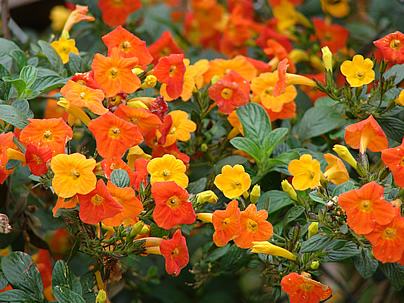The marmalade bush (Streptosolen jamesonii) is an evergreen, climbing shrub with abundant flowers, originating from Bolivia, Colombia, and Peru. It is used as an ornamental plant in various tropical regions around the world. The plant has long, recurved, flexible, and branched branches with a semi-woody texture. Its leaves are oval to elliptical, glossy, dark green, and prominently veined, giving them a polished appearance.
It can bloom throughout the year in favorable climates but is particularly vibrant in spring and summer. Its inflorescences emerge in terminal clusters with numerous trumpet-shaped flowers. The flowers initially appear yellow, gradually transitioning to shades of orange. When observing the blooming bush, one can notice various tones ranging from yellow to orange, attracting hummingbirds, butterflies, and bees seeking its nectar.
The marmalade bush can be shaped in various ways, from a natural and informal appearance to pruned forms, making it an upright and denser shrub. However, it may not be suitable for topiaries. It can also be trained to climb on supports, functioning as a creeper. In its climbing form, the marmalade bush is suitable for crowning walls or smaller supports like pillars.
Due to its climbing nature, it requires ties for support. In its shrub form, it can be used as a standalone feature or in groups, forming masses and rows that can be used to outline paths or soften larger structures and vegetation. It is also suitable for planting in pots and planters.
It should be cultivated in full sun or partial shade, in fertile, well-draining soil enriched with organic matter and regularly irrigated. In very hot climates, it is advisable to grow it in partial shade, with at least 6 hours of direct sunlight daily, avoiding the hottest hours of the day. In milder climates, full sun exposure will result in more intense flowering.
Once well-established, the marmalade bush becomes resistant to short periods of drought, but in locations with intense and dry heat, supplementary irrigation is advisable. It is sensitive to cold and frost. Pruning is allowed for shaping and rejuvenation, always performed after flowering, also removing old, dry, and diseased branches at that time. Propagation can be done through stem cuttings, which are rooted after flowering, and even the removed branches during pruning can be utilized for this purpose.


